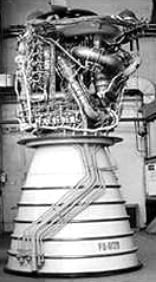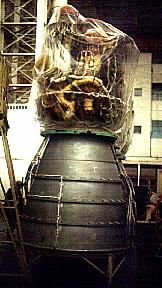
Home - Search - Browse - Alphabetic Index: 0- 1- 2- 3- 4- 5- 6- 7- 8- 9
A- B- C- D- E- F- G- H- I- J- K- L- M- N- O- P- Q- R- S- T- U- V- W- X- Y- Z
RD-0120
AKA: 11D122;RO-200. Status: Design 1987. Date: 1976-90. Number: 10 . Thrust: 1,961.00 kN (440,850 lbf). Unfuelled mass: 3,450 kg (7,600 lb). Specific impulse: 455 s. Specific impulse sea level: 359 s. Burn time: 600 s. Height: 4.55 m (14.92 ft). Diameter: 2.42 m (7.93 ft).
The result was an engine of similar size, thrust, and specific impulse but lower cost. Feed Method: 35,000 rpm dual-stage turbopump. A single pre-burner burns fuel-rich at 527 Celsius to drive the single-shaft high pressure turbopump. Some of the pre-burner gas drives the oxygen low pressure pump. The fuel low pressure pump is driven by GH2 from the main chamber cooling loop.. Throttle range is 45%. Throat diameter 261 mm, exit diameter 2420 mm. The original RD-0120 engines are mothballed at Baikonur.
Although the SSME may have been the starting point, Soviet engine technology led that of the United States in many other detailed points of liquid rocket design. By the mid-1960's the USA had practically abandoned development of liquid fuel engines, with the sole exception of the SSME. The US military preferred to use solid rocket motors for missile and booster stage applications. Russian rocket engineers had spent their entire lives perfecting military liquid fuel rockets and had never favored solid fuel. Therefore Russian Liquid Oxygen/Kerosene and N2O4/UDMH engines were of much higher performance than those in the US. On the other hand the Soviet Union had not developed any Lox/LH2 engines over 40 metric tons thrust and none actually been flown in space. The contribution of unique Soviet technology and the inevitable changes that occurred during development resulted in the MKS RD-0120 main engine being different in detail from the SSME while retaining the same performance.
In the first stages of the development of the RD-0120, different basic engine schemes were evaluated before a single-shaft turbo-pump for both liquid hydrogen and liquid oxygen was selected (the SSME had separate turbo-pumps for each fuel component). Use of a single pump simplified the engine control system and manufacturing, but also required more detailed and sophisticated methods of design and optimization then were available to the Americans. Another principal difference was the absence of resonance chambers, which were used on the SSME for suppression of high frequency vibrations in combustion chamber. The start sequence developed for the RD-0120 was and remains completely unique.
On the other hand Russian engineers observe that the SSME designers used some technologies that were not used previously in the USA but were common in Russia. The best example was the milled combustion chamber, widely used on Russian engines, but never before on American engines.
By 1999 the US was studying incorporation of more RD-0120 technology into the SSME:
The channel-wall nozzle is a proposed replacement for the current SSME nozzle. Employing a process developed in Russia and used for the Russian RD-0120 rocket engine, flat stock is roll formed into a conical shape, which serves as the nozzle liner. The liner is slotted to form channels for the nozzle's liquid hydrogen coolant to flow through. A jacket is then installed over the liner and welded at the ends. The entire assembly is then furnace brazed. The channels in the liner take the place of the 1,080 tubes that regeneratively cool the current SSME nozzle. The channel-wall nozzle is a relatively simple design that has fewer parts and welds than the current complex SSME nozzle. (The current SSME nozzle takes two-and-one-half years to build, costs $7 million, and is currently flown no more than 12 to 15 times because of safety concerns related to hydrogen leaks.) NASA expects the channel-wall nozzle to be more reusable than the current nozzle and to have less risk of critical failure. The new nozzle is also expected to improve engine performance slightly (although any gain in payload capacity may be canceled by the increased nozzle weight), to cost less and take less time to produce, and to cost less to operate. NASA and Rocketdyne (through Aerojet) have spent $0.8 and $1.2 million respectively to study this upgrade, and development could start at the beginning of 1999. The proposed upgrade would cost an estimated $63 million over four years for development and testing, plus an additional $71 million to build 18 certification and production nozzles.
Drawing on this blend of mature American technology and Soviet innovation, the RD-0120 had a relatively trouble-free development program. The final engine represented for the Soviet Union new technical solutions in engine reliability, control, throttleability, and performance. These were the first fully throttleable Soviet engines, and their first production Lox/LH2 engines.
Thrust (sl): 1,517.100 kN (341,058 lbf). Thrust (sl): 154,702 kgf. Engine: 3,450 kg (7,600 lb). Chamber Pressure: 218.00 bar. Area Ratio: 85.7. Thrust to Weight Ratio: 57.97. Oxidizer to Fuel Ratio: 6.
| RD-0120M Kosberg LOx/LH2 rocket engine. Energia-M core stage. Development ended 1993. From 1987 KBKhA worked on upgrading the 11D122 (RD-0120) engine for Energia-M launcher, including the possibility to throttle the engine down to 28% thrust. |
| RD-0120-CH Kosberg LOx/LCH4 rocket engine. Design concept 1990's. Proposed variant of the RD-0120 engine using liquid methane instead of hydrogen as propellant. |
| RD-0122 Kosberg LOx/LH2 rocket engine. Energia-M core stage. Planned for Angara central stage. Developed 1990-. Upgrade of RD-0120 engine for Energia-M launcher with increased thrust. Prototype from RD-0120 hardware. |
| RD-0120M-CH Kosberg LOx/LCH4 rocket engine. Design concept 1990's. Proposed variant of the RD-0120M engine using liquid methane instead of hydrogen as propellant. |
| RD-0120TD Kosberg tri-propellant (LOx/LH2/kerosene) rocket engine. Developed 1990's. 452s. Experimental version of the RD-0120 engine. Tested by supply of high-pressure kerosene from test bench or adapted existing kerosene pump for tests. |
| RD-0750 Kosberg LOx/LH2/kerosene rocket engine. Alternative for Angara central stage, MAKS. Developed 1997-. Tripropellant derivative of RD-0120. Some components tested in RD-0120TD technology demonstration in cooperation with Aerojet. |
| RD-0134 Kosberg LOx/LNG rocket engine. stage 1. Developed 1998-on. Proposed engine for LOX/liquid natural gas. Staged combustion cycle variant of RD-0139. |
| RD-0139 Kosberg LOx/LNG rocket engine. stage 1. Developed 1998-on. Proposed engine for LOX/liquid natural gas. Gas generator cycle with turbine gas injection into supersonic nozzle. |
| RD-0140 Kosberg LOx/LNG rocket engine. stage 2. Developed 1998-on. Proposed engine for LOX/liquid natural gas. Gas generator cycle with turbine gas injection into supersonic nozzle. |
| RD-0141 Kosberg LOx/LNG rocket engine. stage 1. Developed 1998-on. Proposed engine for LOX/liquid natural gas. Staged combustion cycle. Obviously variant of RD-0141 with larger nozzle. |
| RD-0142 Kosberg LOx/LNG rocket engine. stage 2. Developed 1998-on. Proposed engine for LOX/liquid natural gas. Staged combustion cycle. Obviously variant of RD-0141 with larger nozzle. |
Country: Russia. Spacecraft: Albatros. Launch Vehicles: Energia, Vulkan, Interim HOTOL. Propellants: Lox/LH2. Stages: Vulkan 1, Albatros Carrier Aircraft, Energia Core, Energia EUS, Interim HOTOL stage. Agency: Kosberg bureau. Bibliography: 308, 309, 310, 342, 7468.
 | RD-0120 Credit: KBKhA |
Back to top of page
Home - Search - Browse - Alphabetic Index: 0- 1- 2- 3- 4- 5- 6- 7- 8- 9
A- B- C- D- E- F- G- H- I- J- K- L- M- N- O- P- Q- R- S- T- U- V- W- X- Y- Z
© 1997-2019 Mark Wade - Contact
© / Conditions for Use
